Multi-Dimensional Sparse-Coded Ambient Backscatter Communication for Massive IoT Networks
Abstract
1. Introduction
- Direct-Link Interference: We consider separated ambient source and reader for long-range AmBC in contrast to the short-range AmBC with colocated source and reader in [24]. In addition, to effectively cancel DLI, we utilize frequency-domain structure of OFDM carriers from multiple ambient sources, which can be an extension of the works [11,12,25] with single ambient source.
- Multi-Dimensional Signaling: We extend sparse codes [24] designed for specific cases (i.e., , ) in low dimension to generalized cases (i.e., , ) in multi-dimensional signal space. Also, to optimize multi-dimensional signal constellation, we propose a heuristic algorithm which effectively maximizes the minimum Euclidean distance among constellation points. Simulation results demonstrate the feasibility of high-order modulation for the RF tags with small form-factor and BPSK backscatter modulators.
- Reflection Coefficient Projection and Expansion: We modify the low number of projection methods [26,27] considered in active radios with oscillators to support passive ambient backscatter radios implemented via reflection and OFDM carriers from ambient sources. The proposed method can be applied to general AmBC scenarios, extending the previous work [24].
2. System Model
2.1. Notation
2.2. Ambient Source Model
- Data Subcarriers: There are data subcarriers with -ary modulation. Symbols in data subcarriers are denoted by , where is the alphabet set of data subcarriers with cardinality and the index set of data subcarriers with cardinality . These subcarriers are used to transmit data intended for legacy receivers but unknown to the reader which has to decode backscattered signals from multiple tags.
- Pilot Subcarriers: There are pilot subcarriers with -ary modulation. Similar to the above, symbols are denoted by , where is the alphabet set of pilot subcarriers with cardinality and the index set of pilot subcarriers (e.g., 12, 26, 40, 54 in 802.11g Wi-Fi) with cardinality . The pilot subcarriers are required for channel estimation in the legacy OFDM system and generated by known sequences. When the preamble of OFDM frame is received by the reader, the symbols in these subcarriers can be efficiently acquired at the reader. Hence, the pilot subcarriers can act as spreading sequences [11,12,25] enabling reliable AmBC for RF tags.
- Guard Subcarriers: There are guard subcarriers with index where is the index set of guard subcarriers. These subcarriers contain no power to prevent inter-carrier interference from adjacent OFDM carriers and not related to the AmBC systems.
2.3. Channel Model
3. Sparse Codes
3.1. Preliminary: Limitations in Conventional Backscatter
- Short-Range Communication: TDMA-based AmBC (TD-AmBC) system has a short communication range because the ambient backscatter signals received at the reader are significantly attenuated by both the forward channels and backward channels. By poor propagation properties in the composite forward-backward channels, or dyadic backscatter channels [6,7], backscatter signals are too weak to be decoded at the reader when the distance among tags and the reader increases. Furthermore, simple repetition coding by increasing the number of time slots K (equivalently, symbol period) [3,5] in the TD-AmBC is not sufficient enough to combat channel fading in practice. Besides, in the TD-AmBC, only one tag is activated in a time slot for backscatter communication and the rest of tags remain idle (or harvesting energy). By adopting orthogonal multiple access (OMA) among tags in the TD-AmBC, the duty cycle is limited to . If a massive number of tags are connected to the reader, such as in low-power wide area network (LP-WAN), the duty cycle D goes to zero and the data rate of individual tag diminishes accordingly. Hence, by the channel and connectivity issues, the TD-AmBC is limited to short-range applications, typically less than few meters [1,2,3,5].
- Low-Rate Communication: In the TD-AmBC, the data rates of tags decrease when the channel conditions are bad, or there are multiple concurrent backscatter signals from tags to the reader as we discussed above. In addition, due to hardware limitation of the tags with small form-factor, tags’ data is modulated in low-order modulation schemes, typically ranging from (e.g., on-off keying (OOK) [1,2,5] to (e.g., 16-PSK [3], 16-QAM [20]). However, to implement high-order backscatter modulators, we should add a series of load impedances and corresponding RF switches to the tags’ circuit, which inevitably increases installation costs and form-factor of the tags. As such, the TD-AmBC is limited to low-rate applications in practice.
3.2. Characteristics of Sparse Codes
- Multi-Dimensional Signalling: In contrast to the TD-AmBC with duty cycle , sparse-coded AmBC can prolong the duty cycle of RF tags to be by allowing non-orthogonal transmissions among tags. When sparse codes are applied to tags, a codeword encoded by each tag spans for compressed time slots by utilizing sparsity and there exist non-zero elements and zero elements contained in each codeword. By the definition of the duty cycle , sparse codes can prolong the duty cycle of RF tags effectively. Especially, the parameter denotes the dimension of signal constellation which is related to the duty cycle D. Therefore, based on the sparsity of codewords, ambient backscatter signals can be represented in higher dimension for achieving diversity gain [38] by increasing the duty cycle of RF tags. As a result, the multi-dimensional signalling can support long-range AmBC of few tens of meters, enabling the vision of LP-WAN [14].
- Feasibility of High-Order Modulation: Instead of manufacturing the customized M-ary backscatter modulators [3,20,21,22] in the conventional TD-AmBC, sparse codes can implement M-ary modulation at commercial RF tags with small form-factor by employing binary PSK (BPSK) backscatter modulator. Based on the principle of the low number of projection method [26,27], M-ary constellation points can be projected onto reflection coefficients at the tags, and then decoded at the reader by a low-complexity iterative message passing algorithm (MPA). Theoretically, any high-order modulation (e.g., ) can be implemented in AmBC as long as the dimension is large enough to span constellation points. Thus, sparse codes can also achieve high-rate AmBC with reasonable installation costs for massive IoT.
3.3. Design of Constellation Mapping Function
- In the -th column, a vector is repeated times.
- For , the -th column is equal to the -th column where .
| Algorithm 1 Constellation Mapping Matrix Optimization |
|
3.4. Design of Factor Graph
3.5. Duty-Cycling Operation
4. Two-Stage Detection
4.1. Stage-1: Utilizing OFDM Structure
4.2. Stage-2: Utilizing Sparse Code Structure
5. Simulation Results
5.1. Comparison of AmBC Systems: TD-AmBC and MSC-AmBC
5.2. Practical Implementation of AmBC
5.3. Simulation 1: Effect of OFDM Carriers
5.4. Simulation 2: Effect of Duty-Cycling Operation
5.5. Simulation 3: Effect of Signal Constellation
5.6. Simulation 4: Effect of Sparse Codes
6. Conclusions
Author Contributions
Funding
Acknowledgments
Conflicts of Interest
References
- Liu, V.; Parks, A.; Talla, V.; Gollakota, S.; Wetherall, D.; Smith, J.R. Ambient backscatter: Wireless communication out of thin air. In Proceedings of the ACM SIGCOMM’13, Hong Kong, China, 12–16 August 2013; pp. 39–50. [Google Scholar]
- Parks, A.N.; Liu, A.; Gollakota, S.; Smith, J.R. Turbocharging ambient backscatter communication. In Proceedings of the ACM SIGCOMM’14, Chicago, IL, USA, 17–22 August 2014; pp. 619–630. [Google Scholar]
- Bharadia, D.; Joshi, K.R.; Kotaru, M.; Katti, S. BackFi: High throughput WiFi backscatter. In Proceedings of the ACM SIGCOMM’15, London, UK, 17–21 August 2015; pp. 283–296. [Google Scholar]
- Ensworth, J.F.; Reynolds, M.S. Every smart phone is a backscatter reader: Modulated backscatter compatibility with Bluetooth 4.0 low energy (BLE) devices. In Proceedings of the 2015 IEEE International Conference on RFID (IEEE RFID 2015), San Diego, CA,, USA, 15–17 April 2015; pp. 78–85. [Google Scholar]
- Kellogg, B.; Parks, A.; Gollakota, S.; Smith, J.R.; Wetherall, D. Wi-Fi backscatter: Internet connectivity for RF-powered devices. In Proceedings of the ACM SIGCOMM’14, Chicago, IL, USA, 17–22 August 2014; pp. 607–618. [Google Scholar]
- Griffin, J.D.; Durgin, G.D. Link envelope correlation in the backscatter channel. IEEE Commun. Lett. 2007, 11, 735–737. [Google Scholar] [CrossRef]
- Griffin, J.D.; Durgin, G.D. Gains for RF tags using multiple antennas. IEEE Trans. Antennas Propag. 2008, 56, 563–570. [Google Scholar] [CrossRef]
- Liu, H.-C.; Lin, W.-C.; Lin, M.-Y.; Hsu, M.-H. Passive UHF RFID tag with backscatter diversity. IEEE Antennas Wirel. Propag. Lett. 2011, 10, 415–418. [Google Scholar]
- Wang, J.; Hassanieh, H.; Katabi, D.; Indyk, P. Efficient and reliable low-power backscatter networks. In Proceedings of the ACM SIGCOMM’12, Helsinki, Finland, 13–17 August 2012; pp. 61–72. [Google Scholar]
- Liu, W.; Huang, K.; Zhou, X.; Durrani, S. Full-duplex backscatter interference networks based on time-hopping spread spectrum. IEEE Trans. Wirel. Commun. 2017, 16, 4361–4377. [Google Scholar] [CrossRef]
- Yang, G.; Zhang, Q.; Liang, Y.-C. Cooperative ambient backscatter communications for green internet-of-things. IEEE Internet Things J. 2018, 5, 1116–1130. [Google Scholar] [CrossRef]
- Yang, G.; Liang, Y.-C.; Zhang, R.; Pei, Y. Modulation in the air: Backscatter communication over ambient OFDM carrier. Backscatter communications over ambient OFDM signals: Transceiver design and performance analysis. IEEE Trans. Commun. 2018, 66, 1219–1233. [Google Scholar] [CrossRef]
- Guo, J.; Zhou, X.; Durrani, S.; Yanikomeroglu, H. Design of non-orthogonal multiple access enhanced backscatter communication. arXiv, 2018; arXiv:1711.11193. [Google Scholar] [CrossRef]
- Talla, V.; Hessar, M.; Kellogg, B.; Najafi, A.; Smith, J.R.; Gollakota, S. LoRa backscatter: Enabling the vision of ubiquitous connectivity. Proc. ACM Interact. Mob. Wearable Ubiquitous Technol. 2017, 1, 105. [Google Scholar] [CrossRef]
- Boyer, C.; Roy, S. Space time coding for backscatter RFID. IEEE Trans. Wireless Commun. 2013, 12, 2272–2280. [Google Scholar] [CrossRef]
- He, C.; Wang, Z.J.; Miao, C.; Leung, V.C.M. Block-level unitary query: Enabling orthogonal-link space-time code with query diversity for MIMO backscatter RFID. IEEE Trans. Wirel. Commun. 2016, 15, 1937–1949. [Google Scholar] [CrossRef]
- Qian, J.; Parks, A.N.; Smith, J.R.; Gao, F.; Jin, S. IoT communications with M-PSK modulated ambient backscatter: Algorithm, analysis, and implementation. IEEE Internet Things J. 2018. [Google Scholar] [CrossRef]
- Thomas, S.J.; Wheeler, E.; Teizer, J.; Reynolds, M.S. Quadrature amplitude modulated backscatter in passive and semipassive UHF RFID systems. IEEE Trans. Microw. Theory Tech. 2012, 60, 1175–1182. [Google Scholar] [CrossRef]
- Boyer, C.; Roy, S. Coded QAM backscatter modulation for RFID. IEEE Trans. Commun. 2012, 60, 1925–1934. [Google Scholar] [CrossRef]
- Thomas, S.J.; Reynolds, M.S. A 96 Mbit/sec, 15.5 pJ/bit 16-QAM modulator for UHF backscatter communication. In Proceedings of the 2012 IEEE International Conference on RFID (IEEE RFID 2012), Orlando, FL, USA, 3–5 April 2012; pp. 185–190. [Google Scholar]
- Besnoff, J.; Abbasi, M.; Ricketts, D.S. High data-rate communication in near-field RFID and wireless power using higher order modulation. IEEE Trans. Microw. Theory Tech. 2016, 64, 401–413. [Google Scholar] [CrossRef]
- Jordao, M.; Correia, R.; Carvalho, N.B. High order modulation backscatter systems characterization. In Proceedings of the 2018 IEEE Topical Conference on Wireless Sensors and Sensor Networks (WiSNet), Anaheim, CA, USA, 14–17 January 2018; pp. 44–46. [Google Scholar]
- Nikopour, H.; Baligh, H. Sparse code multiple access. In Proceedings of the 2013 IEEE 24th International Symposium on Personal Indoor and Mobile Radio Communications (PIMRC Workshops), London, UK, 8–9 September 2013; pp. 332–336. [Google Scholar]
- Kim, T.Y.; Kim, D.I. Novel sparse-coded ambient backscatter communication for massive IoT connectivity. arXiv, 2018; arXiv:1806.02975. [Google Scholar] [CrossRef]
- Darsena, D.; Gelli, G.; Verde, F. Modeling and performance analysis of wireless networks with ambient backscatter devices. IEEE Trans. Commun. 2017, 65, 1797–1814. [Google Scholar] [CrossRef]
- Wu, Y.; Zhang, S.; Chen, Y. Iterative multiuser receiver in sparse code multiple access systems. In Proceedings of the 2015 IEEE International Conference on Communications (ICC), London, UK, 8–12 June 2015; pp. 2918–2923. [Google Scholar]
- Bayesteh, A.; Nikopour, H.; Taherzadeh, M.; Baligh, H.; Ma, J. Low complexity techniques for SCMA detection. In Proceedings of the 2015 Globecom Workshops (GC Wkshps), San Diego, CA, USA, 6–10 December 2015. [Google Scholar]
- Dai, L.; Wang, B.; Yuan, Y.; Han, S.; Chih-Lin, I.; Wang, Z. Non-orthogonal multiple access for 5G: Solutions, challenges, opportunities, and future research trends. IEEE Commun. Mag. 2015, 53, 74–81. [Google Scholar] [CrossRef]
- Cai, Y.; Qin, Z.; Cui, F.; Li, G.Y.; McCann, J.A. Modulation and multiple access for 5G networks. IEEE Commun. Surv. Tutor. 2018, 20, 629–646. [Google Scholar] [CrossRef]
- Liu, Y.; Ding, Z.; Elkashlan, M.; Poor, H.V. Cooperative non-orthogonal multiple access with simultaneous wireless information and power transfer. IEEE J. Sel. Areas Commun. 2016, 34, 938–953. [Google Scholar] [CrossRef]
- Liu, Y.; Wang, G.; Dou, Z.; Zhong, Z. Coding and detection schemes for ambient backscatter communication systems. IEEE Access 2017, 5, 4947–4953. [Google Scholar] [CrossRef]
- Lu, X.; Niyato, D.; Jiang, H.; Kim, D.I.; Xiao, Y.; Han, Z. Ambient backscatter assisted wireless powered communications. IEEE Wirel. Commun. 2018, 35, 170–177. [Google Scholar] [CrossRef]
- Cai, X.; Giannakis, G.B. Error probability minimizing pilots for OFDM with M-PSK modulation over Rayleigh-fading channels. IEEE Trans. Veh. Technol. 2004, 53, 146–155. [Google Scholar] [CrossRef]
- Wang, Z.; Giannakis, G.B. Wireless multicarrier communications: Where Fourier meets Shannon. IEEE Sig. Process. Mag. 2000, 17, 29–48. [Google Scholar] [CrossRef]
- Talla, V.; Smith, J.R. Hybrid analog-digital backscatter: A new approach for battery-free sensing. In Proceedings of the 2013 IEEE International Conference on RFID (IEEE RFID 2013), Penang, Malaysia, 30 April–2 May 2013; pp. 74–81. [Google Scholar]
- Taherzadeh, M.; Nikopour, H.; Bayesteh, A.; Baligh, H. SCMA codebook design. In Proceedings of the 2014 IEEE 80th Vehicular Technology Conference (VTC Fall), Vancouver, BC, Canada, 14–17 September 2014. [Google Scholar]
- Au, K.; Zhang, L.; Nikopour, H.; Yi, E.; Bayesteh, A.; Vilaipornsawai, U.; Ma, J.; Zhu, P. Uplink contention based SCMA for 5G radio access. In Proceedings of the 2014 Globecom Workshops (GC Wkshps), Austin, TX, USA, 8–12 December 2014; pp. 900–905. [Google Scholar]
- Boutros, J.; Viterbo, E. Signal space diversity: A power- and bandwidth-efficient diversity technique for the Rayleigh fading channel. IEEE Trans. Inf. Theory 1998, 44, 1453–1467. [Google Scholar] [CrossRef]
- Peng, J.; Chen, W.; Bai, B.; Guo, X.; Sun, C. Joint optimization of constellation with mapping matrix for SCMA codebook design. IEEE Sig. Process. Lett. 2017, 24, 264–268. [Google Scholar] [CrossRef]
- Han, K.; Huang, K. Wirelessly powered backscatter communication networks: Modeling, coverage and capacity. IEEE Trans. Wirel. Commun. 2017, 16, 2548–2561. [Google Scholar] [CrossRef]
- Kim, Y.-H.; Ahn, H.-S.; Yoon, C.; Lim, Y.; Lim, S.-O. An ambient RF energy harvesting and backscatter modulating tag system enabling zero-power wireless data communication. In Proceedings of the Seventh International Conference on the Internet of Things (IoT ’17), Linz, Austria, 22–25 October 2017. [Google Scholar]
- Donoho, D.L. Compressed sensing. IEEE Trans. Inf. Theory 2006, 52, 1289–1306. [Google Scholar] [CrossRef]
- Robertson, P.; Villebrun, E.; Hoeher, P. A comparison of optimal and sub-optimal MAP decoding algorithms operating in the log domain. In Proceedings of the 1995 IEEE International Conference on Communications (ICC), Seattle, WA, USA, 18–22 June 1995; pp. 1009–1013. [Google Scholar]
- Hoshyar, R.; Wathan, F.P.; Tafazolli, R. Novel low-density signature for synchronous CDMA systems over AWGN channel. IEEE Trans. Sig. Process. 2008, 56, 1616–1626. [Google Scholar] [CrossRef]
- ISO/IEC Standard for Information Technology—Telecommunications and Information Exchange between Systems—Local and Metropolitan Area Networks—Specific Requirements Part 11: Wireless LAN Medium Access Control (MAC) and Physical Layer (PHY) Specifications (Includes ISO/IEC 8802-11 IEEE Std 802.11 Second edition 2005-08-01 ISO/IEC 8802 11:2005(E) IEEE Std 802.11i-2003 Edition); IEEE: Piscataway, NJ, USA, 2005; pp. 1–721.
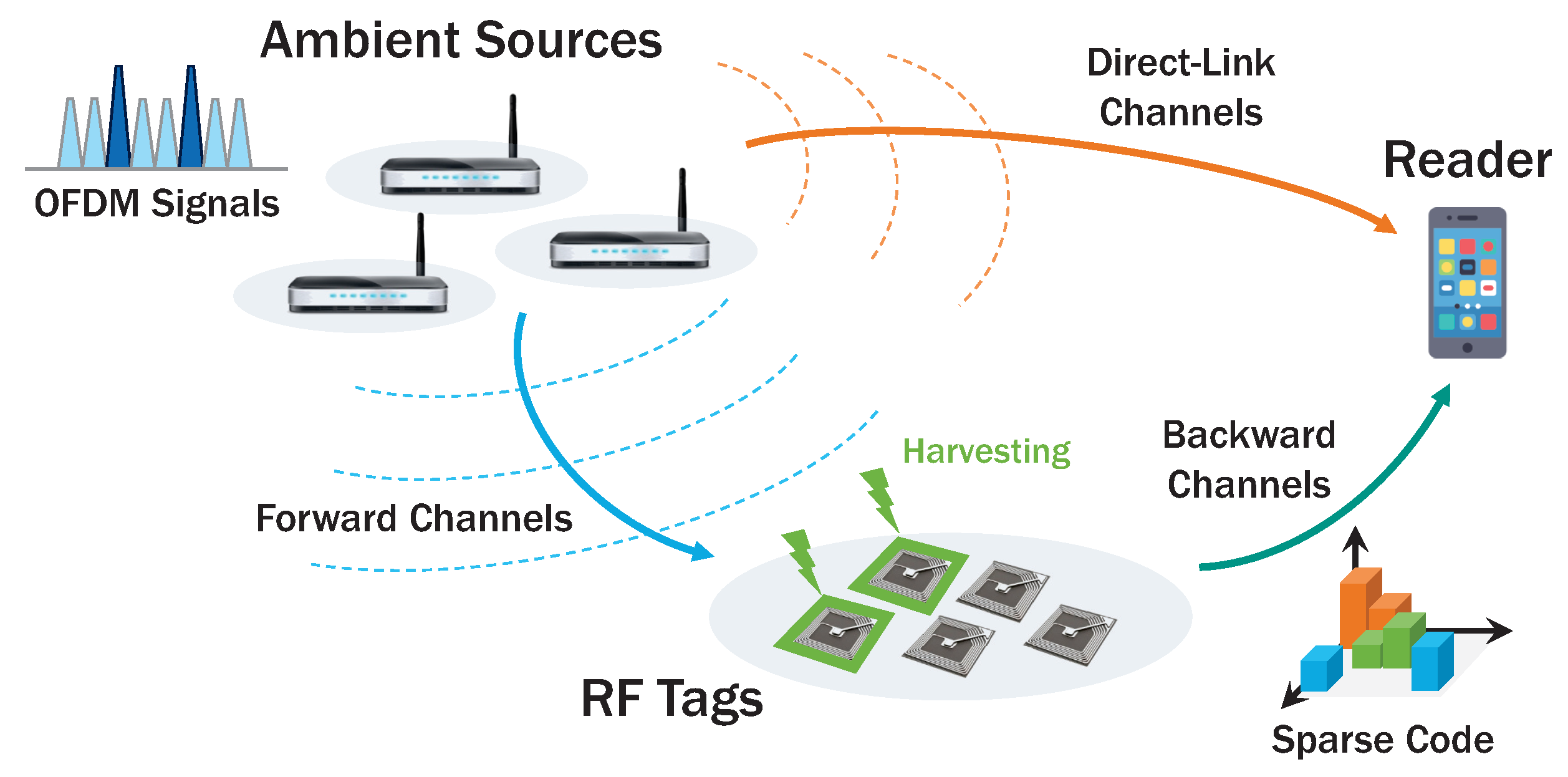
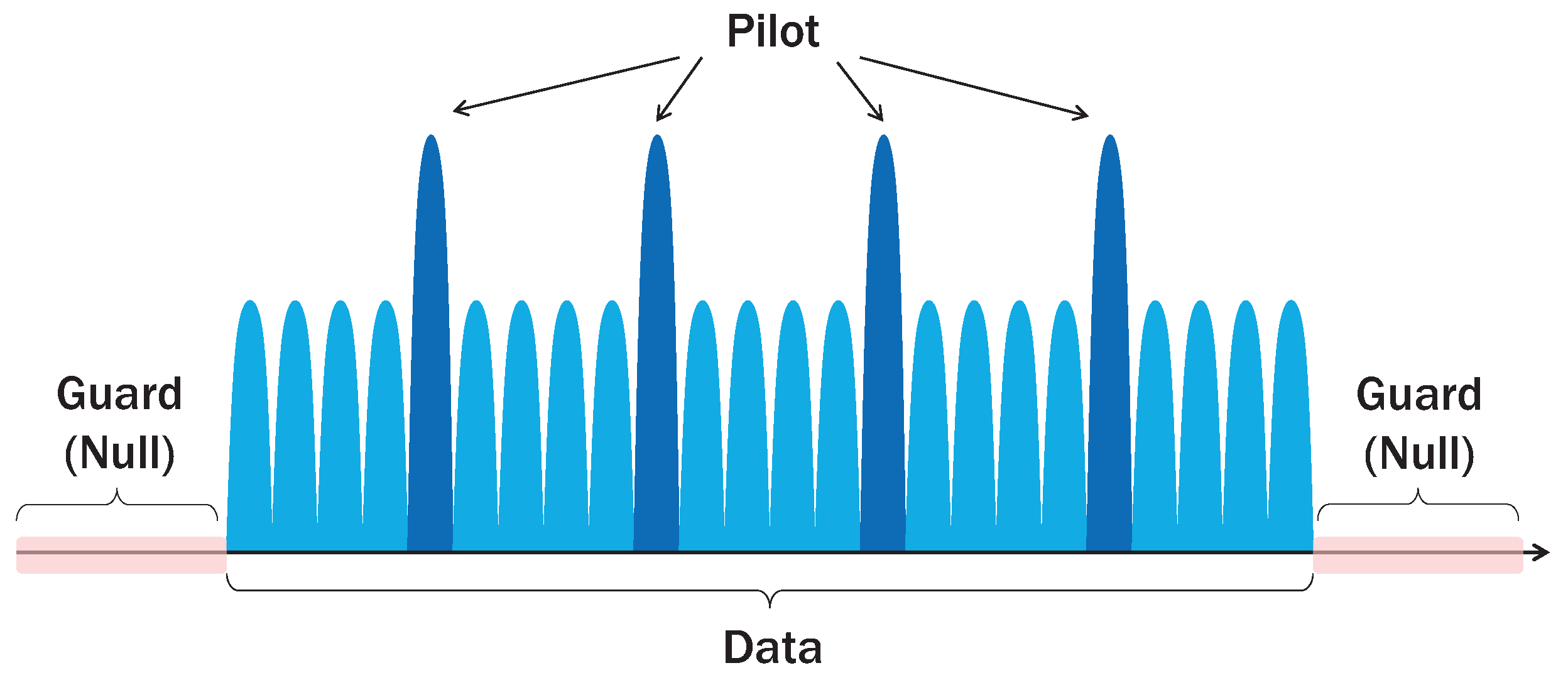
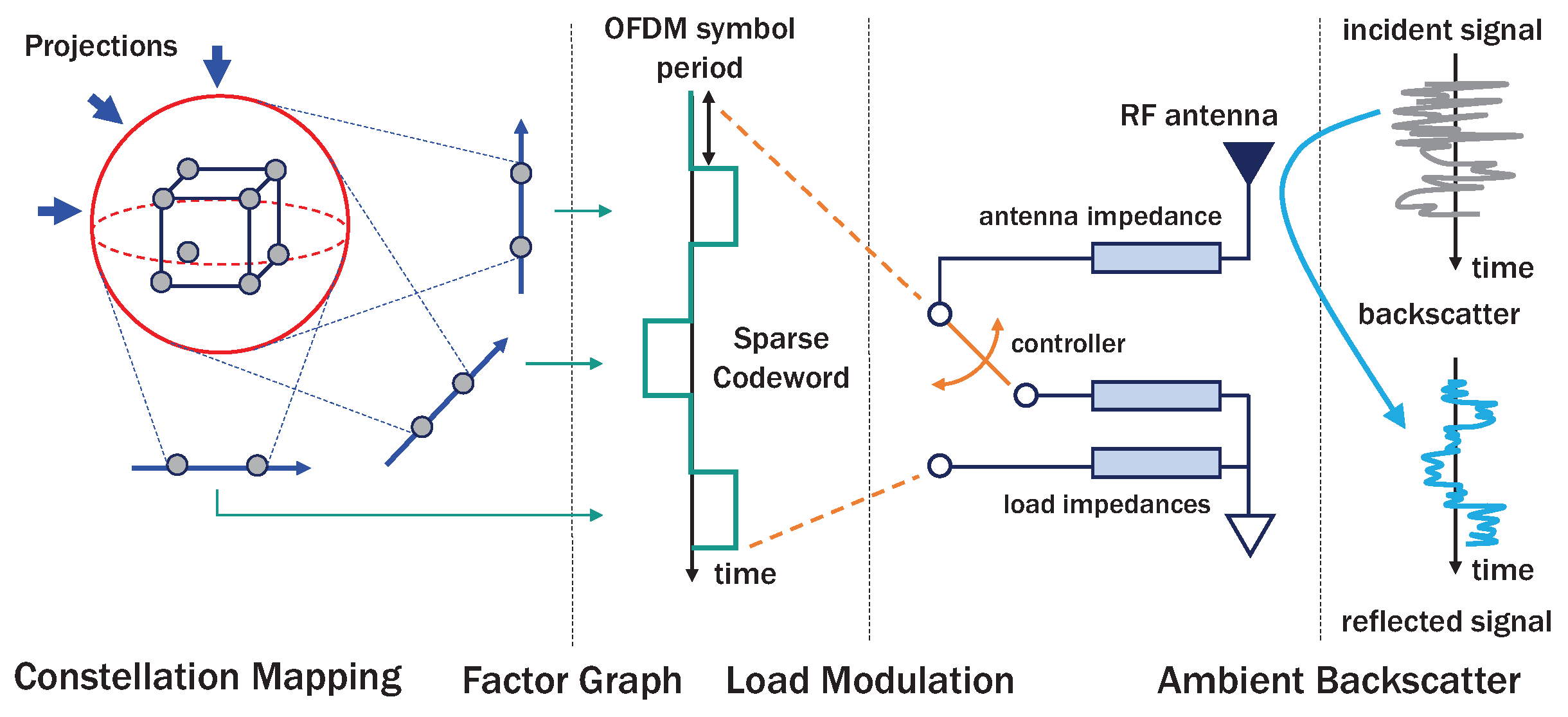
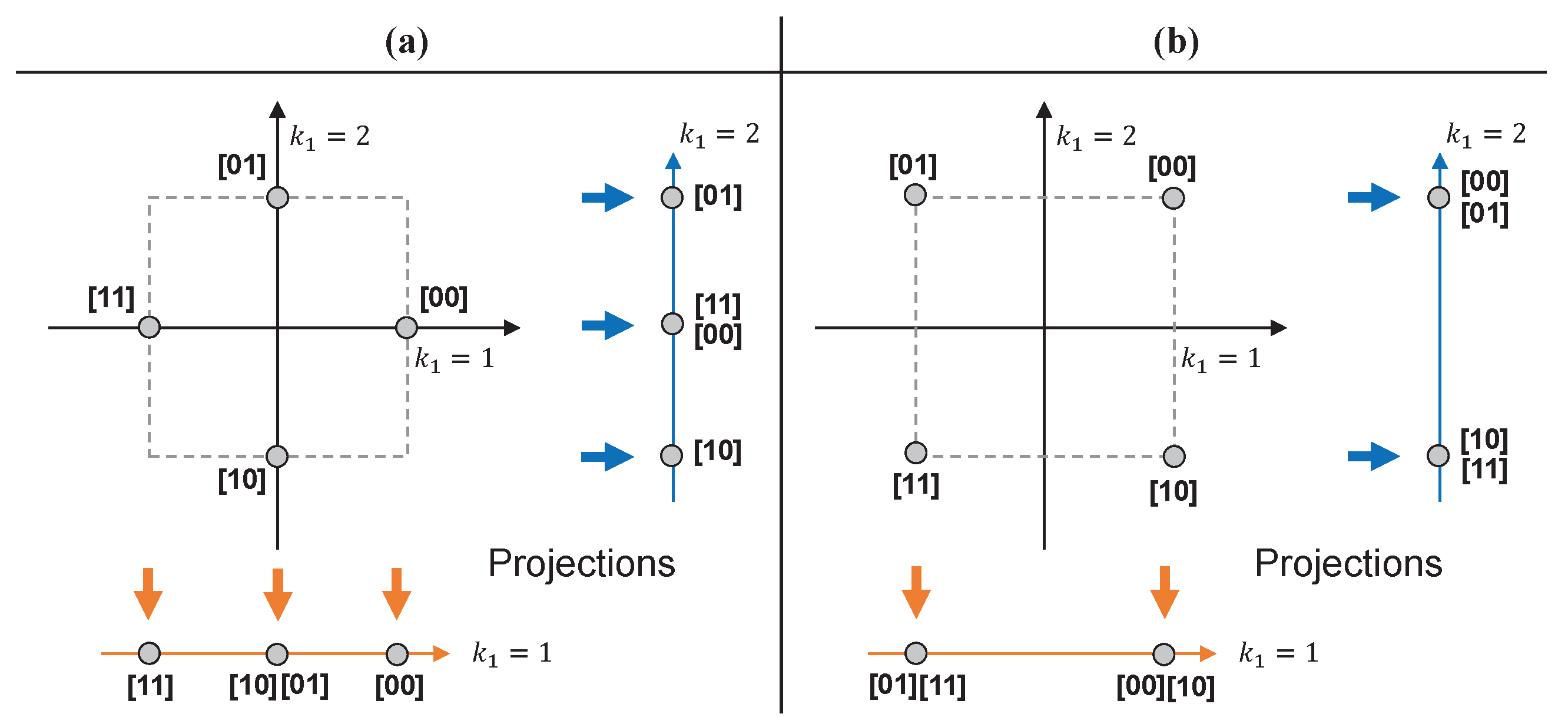

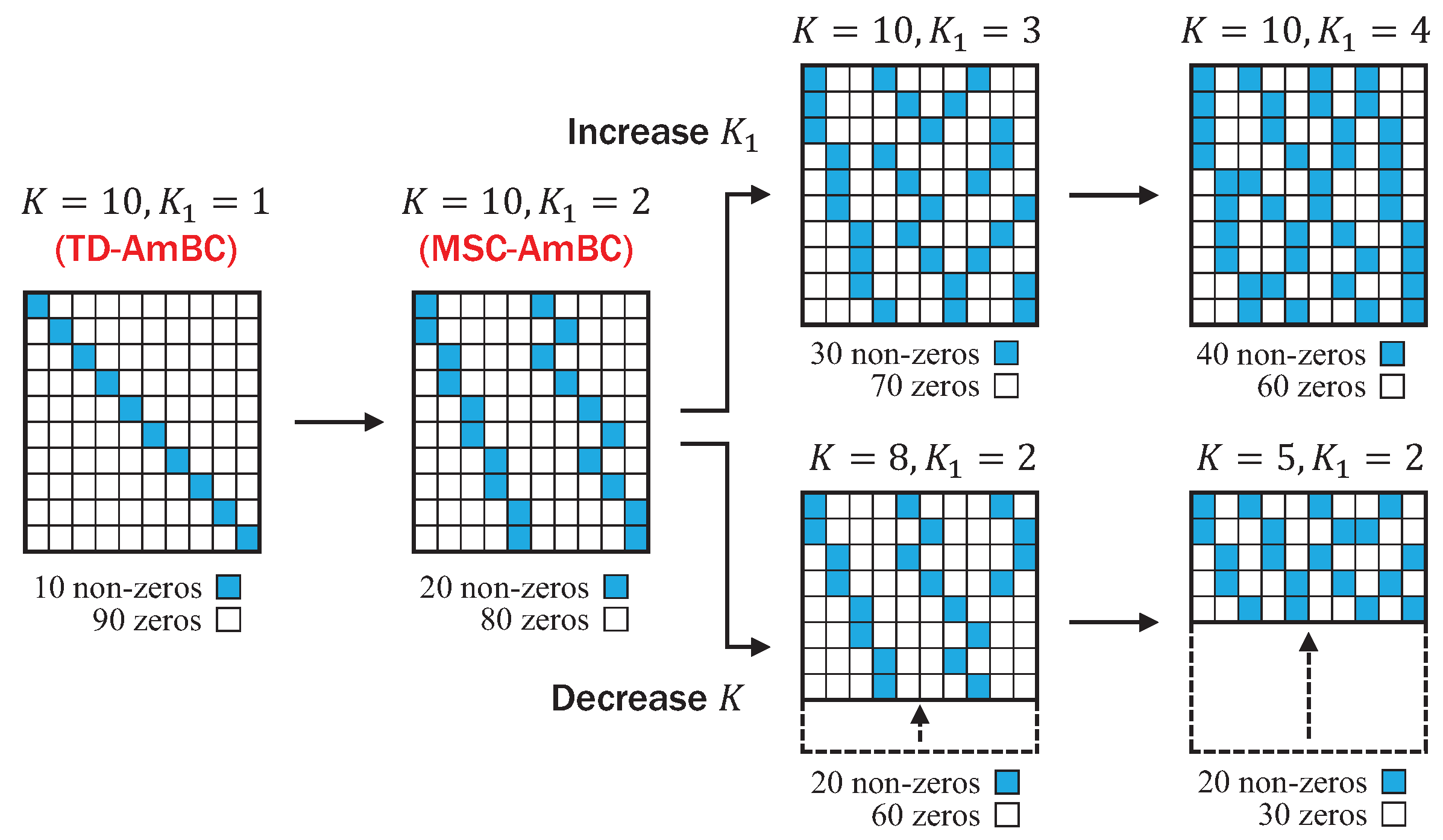
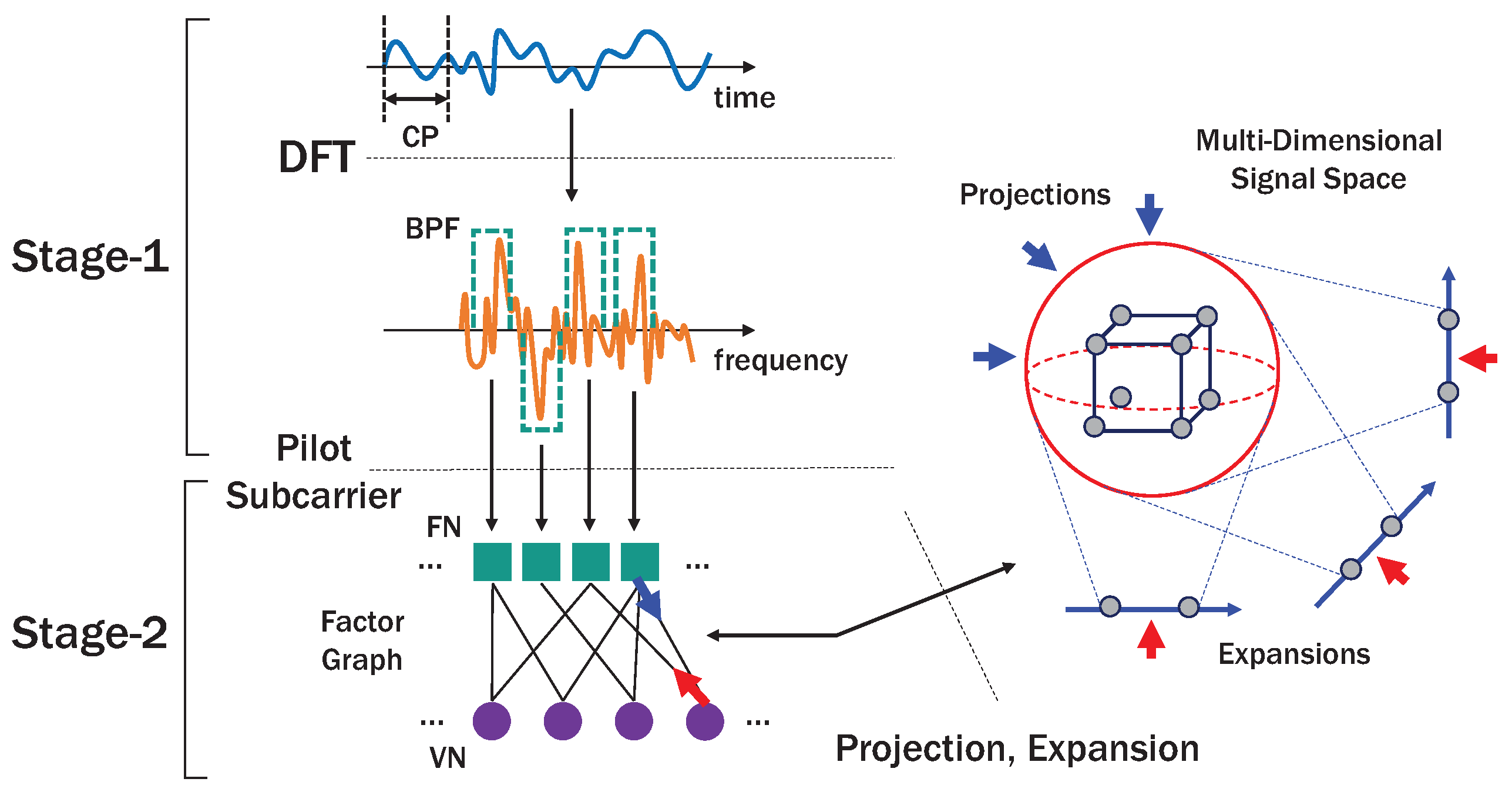

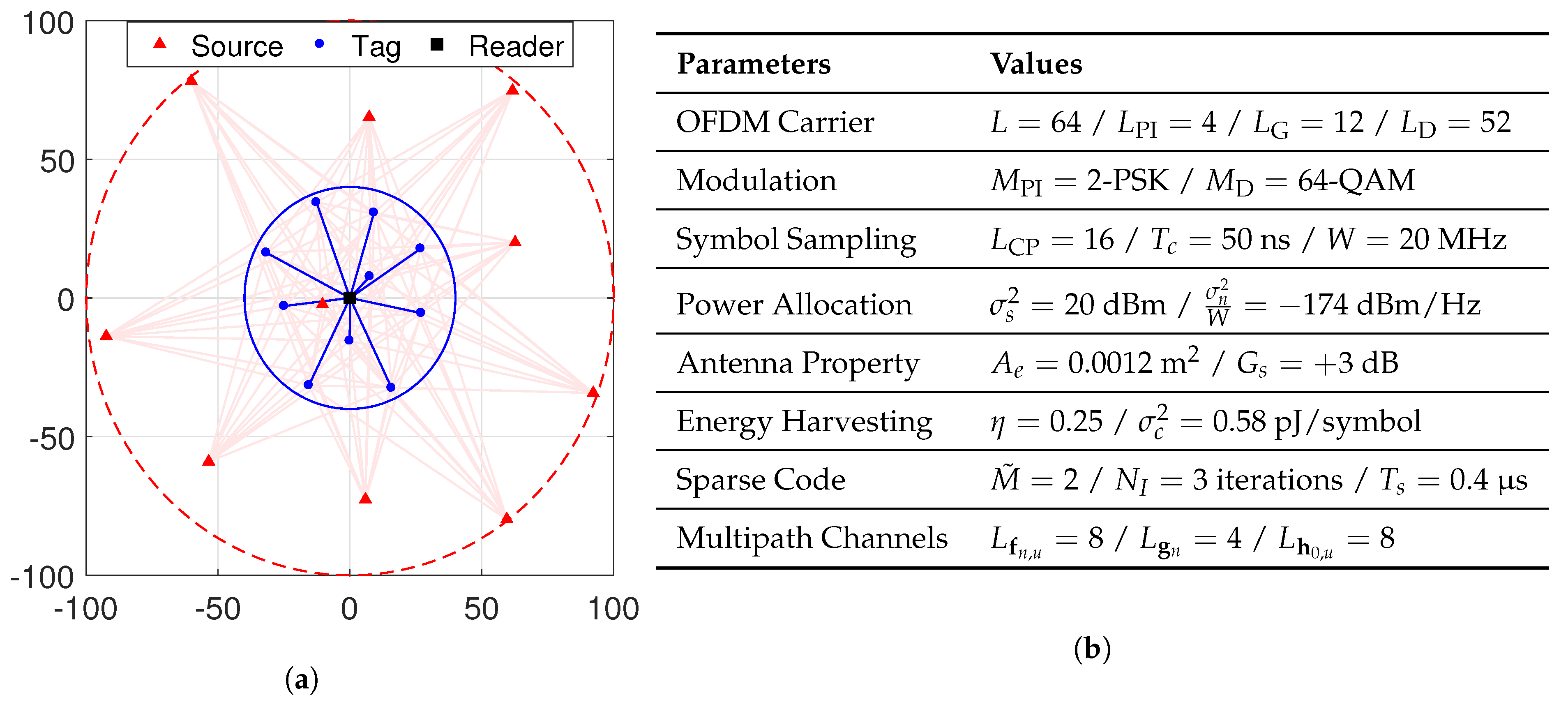
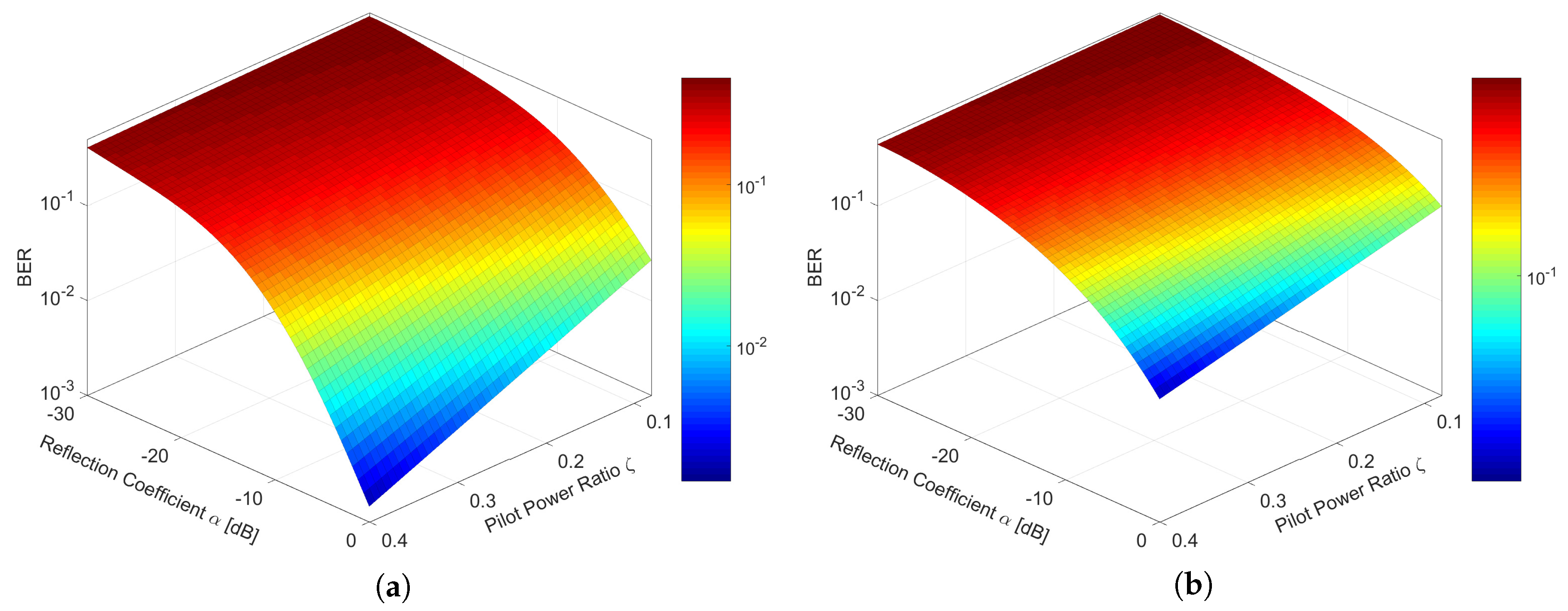
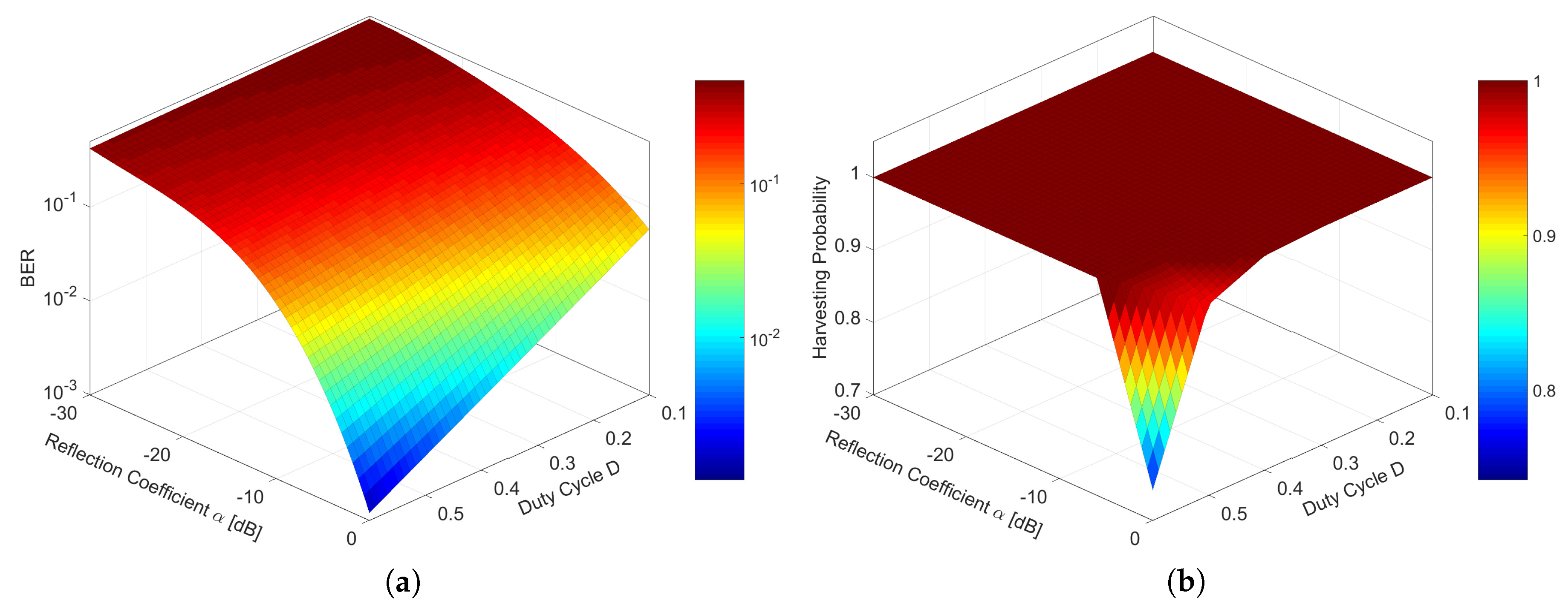
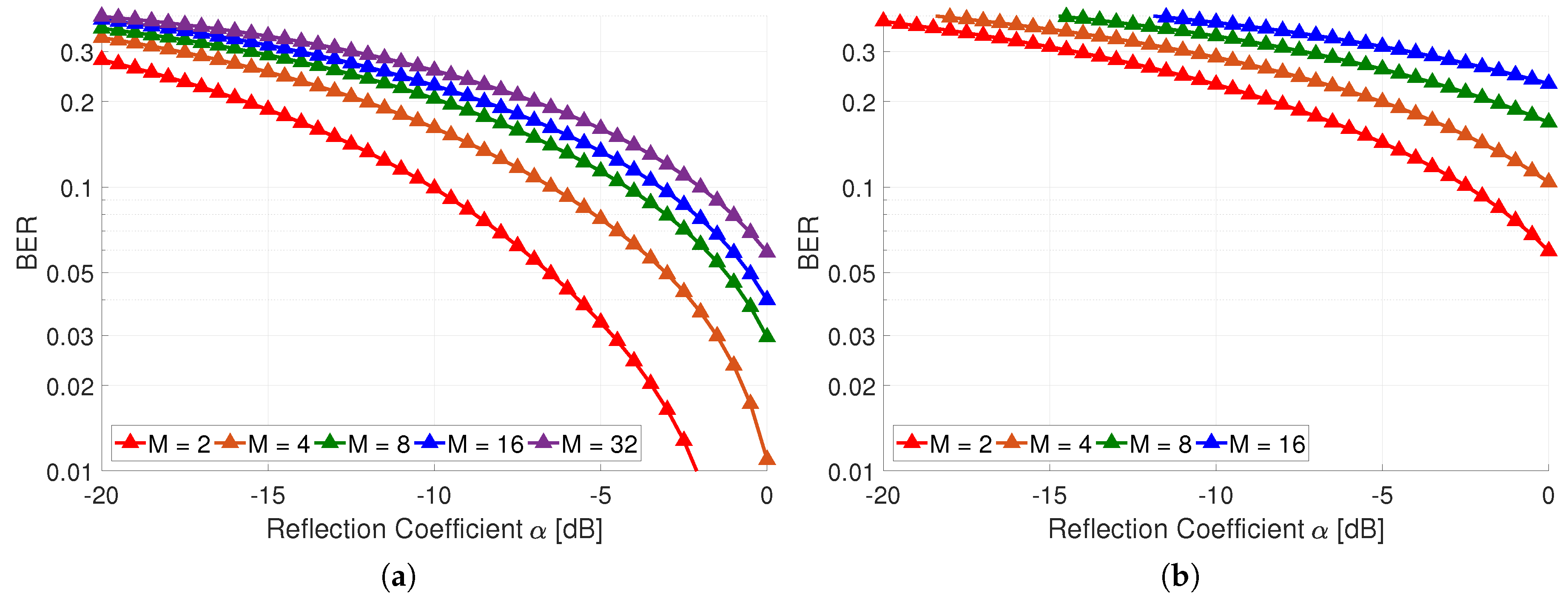
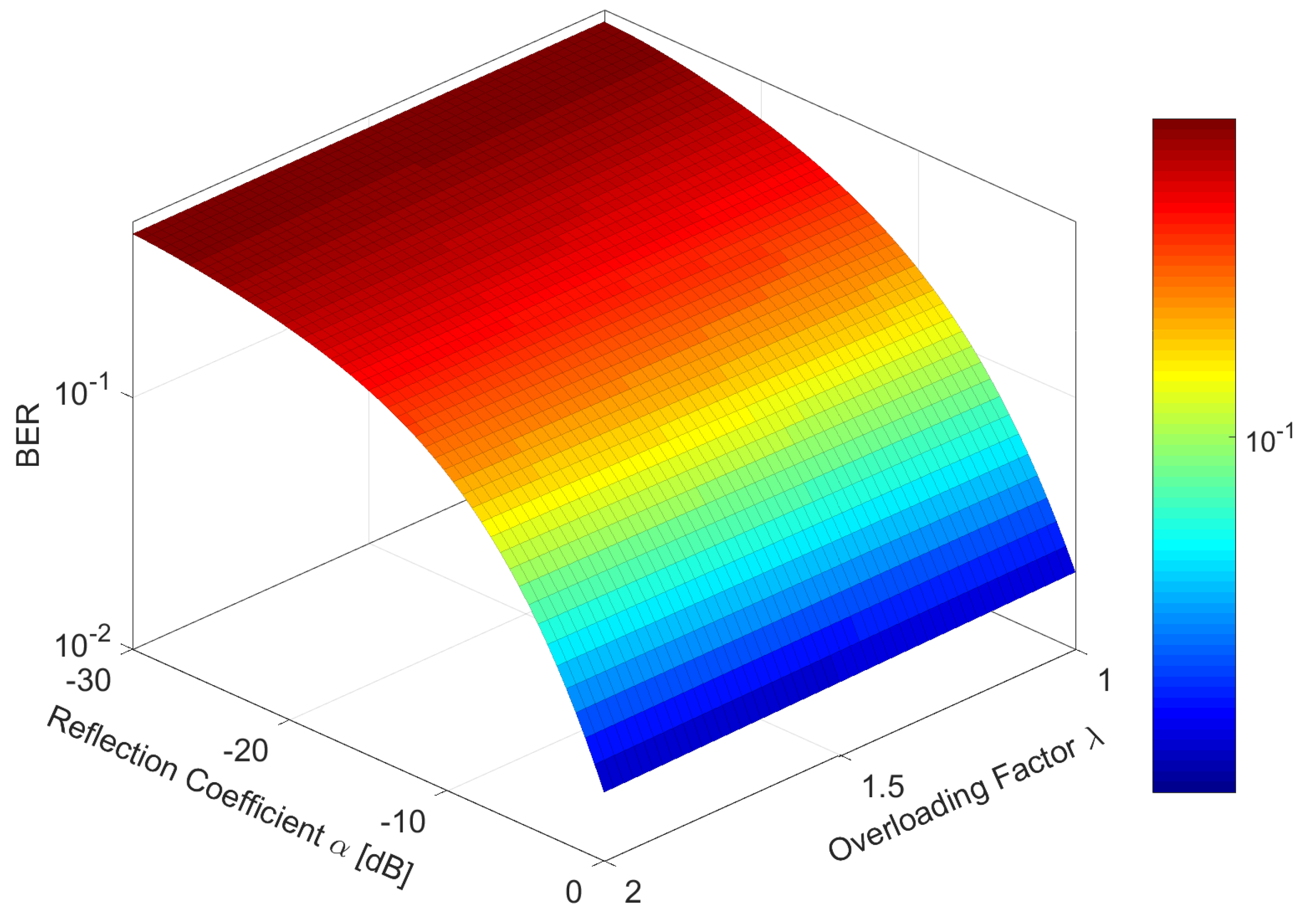
| Component | TD-AmBC | MSC-AmBC |
|---|---|---|
| (1) Modulation | [3,17,18,19,20,21,22] | |
| Signal constellation | 2-dimensional PSK/QAM | dimensional lattice |
| Load impedance | impedances | impedances only () |
| Symbol mapping | direct-mapping (M-to-M) | reflection coefficient projection (M-to-) |
| (2) Coding | [3,10,32] | |
| Multiple access | OMA using TDMA | NOMA using sparse code |
| Duty cycle | limited to | extended to where , |
| Codeword | orthogonal (or diagonal) | non-orthogonal and interfering codes |
| (3) Detection | [3,11,25] | |
| Diversity combining | N parallel MRC blocks | integrated MPA with FNs and N VNs |
| ML detection | hypothesis test in 2 dimension | projection & expansion in dimension |
© 2018 by the authors. Licensee MDPI, Basel, Switzerland. This article is an open access article distributed under the terms and conditions of the Creative Commons Attribution (CC BY) license (http://creativecommons.org/licenses/by/4.0/).
Share and Cite
Kim, T.Y.; Kim, D.I. Multi-Dimensional Sparse-Coded Ambient Backscatter Communication for Massive IoT Networks. Energies 2018, 11, 2855. https://doi.org/10.3390/en11102855
Kim TY, Kim DI. Multi-Dimensional Sparse-Coded Ambient Backscatter Communication for Massive IoT Networks. Energies. 2018; 11(10):2855. https://doi.org/10.3390/en11102855
Chicago/Turabian StyleKim, Tae Yeong, and Dong In Kim. 2018. "Multi-Dimensional Sparse-Coded Ambient Backscatter Communication for Massive IoT Networks" Energies 11, no. 10: 2855. https://doi.org/10.3390/en11102855
APA StyleKim, T. Y., & Kim, D. I. (2018). Multi-Dimensional Sparse-Coded Ambient Backscatter Communication for Massive IoT Networks. Energies, 11(10), 2855. https://doi.org/10.3390/en11102855





